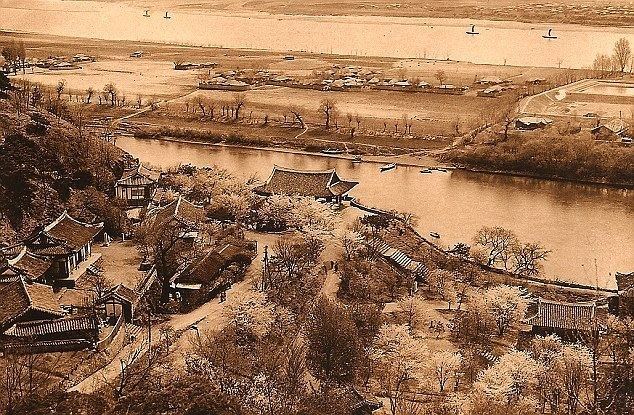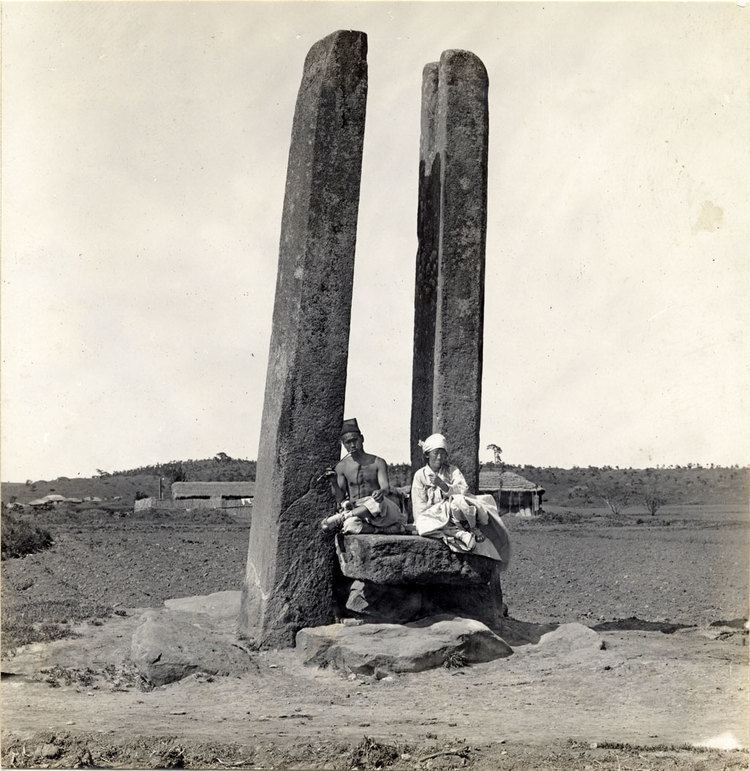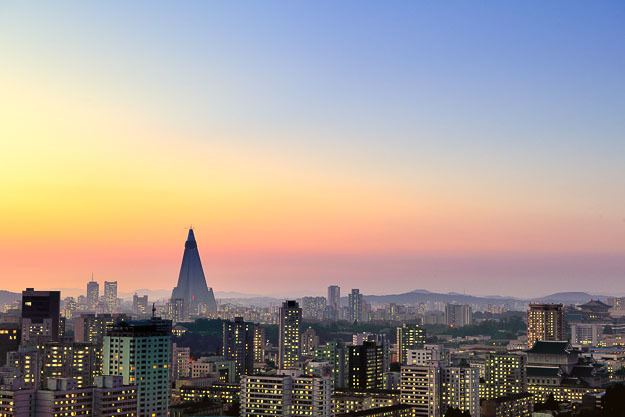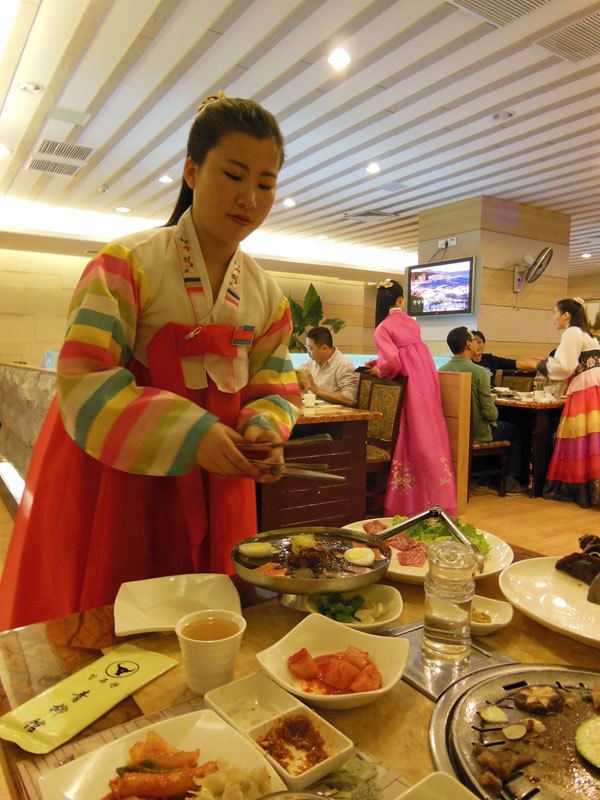Country Population 2.581 million (2008) Area 1,100 km2 | Region Pyongan Founded 1122 BC | |
Points of interest Colleges and Universities Kim Il-sung University, Pyongyang University of Science and Technology, Kim Chaek University of Technology, Pyongyang University of Music and Dance, Kim Il-sung Military University | ||
Pyongyang ( (Chosongul: ; hancha: ), , literally: "Flat Land" or "Peaceful Land", approved: P’yongyang; several variants) is the capital of the Democratic Peoples Republic of Korea (commonly known as North Korea) and the largest city in the country. Pyongyang is located on the Taedong River and, according to preliminary results from the 2008 population census, has a population of 3,255,388. The city was split from the South Pyongan province in 1946. It is administered as a directly governed city (chikhalsi, ???) on the same level as provincial governments, not a special city (teukbyeolsi, ???) as Seoul in South Korea.
Contents
Map of Pyongyang
Facts
Prehistory

In 1955, archaeologists excavated evidence of prehistoric occupation in a large ancient village in the Pyongyang area, called Kumtan-ni, dating to the Chulmun and Mumun pottery periods. North Koreans associate Pyongyang with "Asadal" (), or Wanggomsong (), the first second millennium BC capital of the Gojoseon kingdom according to Korean history books, notably Samguk Yusa. Many South Korean historians deny this claim because other Korean history books place Asadal around the Liao River located in western Manchuria. The connection between the two therefore may have been asserted by North Korea for the use of propaganda. Nevertheless, Pyongyang became a major city under Gojoseon.
History
Pyongyang was founded in 1122 BC on the site of Tangun Dynastys capital, according to legends. It is likely that the area of Pyongyang belonged to Wiman Joseon, the longest-lasting part of Gojoseon, which fell in the Gojoseon–Han War in 108 BC. Emperor Wu of the Han dynasty ordered four commanderies be set up, with Lelang Commandery in the center and its capital established as ?? (Old Chinese: *bre?*na??, modern Mandarin: pingrang, Korean: pyongyang). Several archaeological findings from the later, Eastern Han (25–220 AD) period in the Pyongyang area seems to suggest that Han forces later launched brief incursions around these parts.

The area around the city was called Nanglang during the early Three Kingdoms period. As the capital of Nanglang kingdom (), Pyongyang remained an important commercial and cultural outpost after Lelang Commandery was destroyed by an expanding Goguryeo in 313.
Goguryeo moved its capital there in 427. According to Christopher Beckwith, Pyongyang is the Sino-Korean reading of the name they gave it in their language: Piarna, or "level land".
In 668, Pyongyang became the capital of the Protectorate General to Pacify the East established by the Tang dynasty of China. However, by 676, it was taken by Silla, but left on the border between Silla and Balhae (Bohai). This lasted until the time of the Goryeo dynasty, when the city was revived as Sogyong (Hangul: ; hanja: ; "Western Capital") although it was never actually a capital of the kingdom. It was the provincial capital of the Pyeongan Province during the Joseon dynasty.
During the Japanese invasions of Korea (1592–98), Pyongyang was captured by the Japanese. Later in the 17th century, it came under Manchu control during the Second Manchu invasion of Korea. While the invasions made Koreans suspicious of foreigners, the influence of Christianity began to grow after the country opened itself up to foreigners in the 16th century. Pyongyang became the base of Christian expansion in Korea, and by 1880 it had more than 100 churches and more Protestant missionaries than any other Asian city.
In 1890, the city had 40,000 inhabitants. It was the site of an important battle during the First Sino-Japanese War, which led to the destruction and depopulation of much of the city. However, it was the provincial capital of South Pyeongan Province from 1896. Under colonial rule, the city became an industrial center, called Heijo in Japanese.
In July 1931 the city experienced Anti-Chinese riots as a result of the Wanpaoshan Incident and the sensationalized media reports of the incident which appeared in Japanese and Korean newspapers.
By 1938, Pyongyang had a population of 235,000.
Geography and climate

Pyongyang is in the west-central part of North Korea; the city lies on a flat plain about 50 kilometres (31 mi) east of the Korea Bay, an arm of the Yellow Sea. The Taedong River flows southwestward through the city toward the Korea Bay. The Pyongyang plain, where the city is situated, is one of the two large plains on the Western coast of the Korean peninsula, the other being the Chaeryong plain. Both have an area of approximately 500 square kilometers.

Pyongyang has a humid continental climate (Koppen climate classification Dwa). Cold, dry winds can blow from Siberia in winter, making conditions very cold; the low temperature is usually below freezing between November and early March, although the average daytime high is at least a few degrees above freezing in every month except January. The winter is generally much drier than summer, with snow falling for 37 days on average.
The transition from the cold, dry winter to the warm, wet summer occurs rather quickly between April and early May, and there is a similar abrupt return to winter conditions in late October and November. Summers are generally hot and humid, with the East Asian monsoon taking place from June until August; these are also the hottest months, with average temperatures of 21 to 25 °C (70 to 77 °F), and daytime highs often above 30 °C (86 °F).
Culture
The capital has been completely redesigned since the Korean War (1950–53). It is designed with wide avenues, imposing monuments and monolithic buildings. The tallest structure in the city is the uncompleted 330-metre (1,080 ft) Ryugyong Hotel. This hotel has 105 floors and encloses 361,000 square metres (3,890,000 sq ft) of floor space. The original plan called for crowning it with seven revolving restaurants.

Notable landmarks in the city include:
Pyongyang TV Tower is a minor landmark. Other visitor attractions include the Korea Central Zoo. The Arch of Reunification has a map of a united Korea supported by two concrete Korean women dressed in traditional dress straddling the Reunification Highway, which stretches from Pyongyang to the Korean Demilitarized Zone (DMZ).
Economy
Pyongyang is North Koreas industrial center. Thanks to the abundance of natural resources like coal, iron and limestone, as well as good land and water transport systems, it was the first industrial city to emerge in North Korea after the Korean War. Light and heavy industries are both present and have developed in parallel. Heavy manufactures include cement, industrial ceramics, munitions and weapons, but mechanical engineering remains the core industry. Light industries in Pyongyang and its vicinity include textiles, footwear and food, among others. Special emphasis is put on the production and supply of fresh produce and subsidiary crops in farms on the citys outskirts. Other crops include rice, corn and soybeans. Pyongyang aims to achieve self-sufficiency in meat production. High-density facilities raise pigs, chicken and other livestock.
Cuisine

Pyongyang, nowadays the capital of North Korea was also the capital of Gojoseon, and the provincial capital of Pyongan province until 1946. Therefore, Pyongyang cuisine shares with the general culinary tradition of Pyongan province. The most famous local food is Pyongyang naengmyeon, or also called mul naengmyeon or just simply naengmyeon. Naengmyeon literally means "cold noodles", while the affix, mul refers to "water" because the dish is served in a cold soup. Naengmyeon consists of thin and chewy buckwheat noodles in the cold broth mixed with a meat broth, and dongchimi (watery kimchi) and topped with a slice of sweet Korean pear. Pyongyang naengmyeon was originally eaten at home built with ondol (traditional underfloor heating) during the cold winter, so is also humorously called "Pyongyang deoldeori" (shivering in Pyongyang). Pyongyang locals sometimes enjoyed it as a haejangguk which is any type of food eaten as a hangover cure while commonly a warm soup in form.
Another representative Pyongyang dish is Taedonggang sungeoguk, meaning "trout soup from the Taedong River". The soup is made with trout, which are abundant in the Taedong River, along with black peppercorns and salt. It is served as a courtesy for important guests visiting Pyongyang. Therefore, the question, "How good was the taste of the trout soup?" is commonly used to greet people returning from Pyongyang. In addition, Pyongyang onban (literally "warm rice of Pyongyang") is a local specialty. It is a rice dish made with freshly cooked rice topped with sliced mushrooms and chicken, and a couple of bindaetteok (pancakes made from ground mung beans and vegetables).
Pyongyang served as the provincial capital of Pyeongan province until 1946, and Pyongyang cuisine shares the general culinary tradition of the Pyeongan province. The most famous local food is Pyongyang naengmyeon, or also called mul naengmyeon or just simply naengmyeon. Naengmyeon literally means "cold noodles", while the affix mul refers to "water" because the dish is served in a cold broth. Naengmyeon consists of thin and chewy buckwheat noodles in a cold meat-broth with dongchimi (watery kimchi) and topped with a slice of sweet Korean pear. Pyongyang naengmyeon was originally eaten in homes built with ondol (traditional underfloor heating) during the cold winter, so it is also humorously called "Pyongyang deoldeori" (shivering in Pyongyang). Pyongyang locals sometimes enjoyed it as a haejangguk, which is any type of food eaten as a hangover-cure, usually a warm soup.

Another representative Pyongyang dish, Taedonggang sungeoguk, translates as "trout soup from the Taedong River". The soup features trout (abundant in the Taedong River) along with black peppercorns and salt. It is served as a courtesy to important guests visiting Pyongyang. Therefore, the question "How good was the trout soup?" is commonly used to greet people returning from Pyongyang. Another local specialty, Pyongyang onban (literally "warm rice of Pyongyang"), comprises freshly cooked rice topped with sliced mushrooms, chicken, and a couple of bindaetteok (pancakes made from ground mung beans and vegetables).
Famous restaurants in the city include Okryugwan and Chongryugwan.
